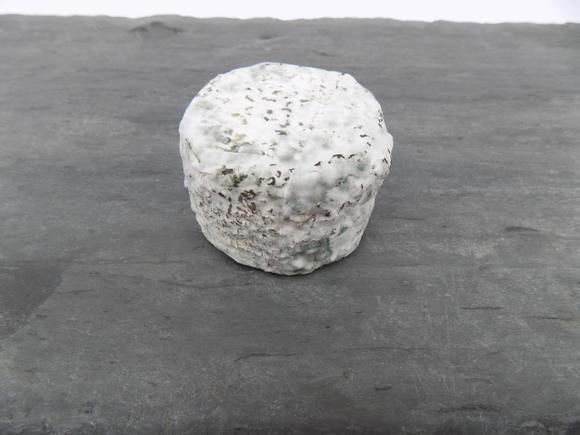
[I’m writing fast in the interest of posting as much as possible as soon as possible, so please excuse my typos! I’ll go through later on to clean those up for posterity…]
The Denver dawn was sunny and clear despite my weater apps prediction of four rainy days…which still could happen, but this morning I shared my walk to the convention center with dog walkers out in shorts or yoga pants and flipflops.
Breakfast was a “Vermont Pancake Breakfast” sponsored by the Vermont Cheese Council where I learned that Vermont has 56 cheese makers in the state who produce 630 million pounds of cheese annually…! Maine may have many more cheese makers at this point, but we lag Just A Wee Bit behind the Green Mountain State in volume. A little bit. However, during the welcome talks by Executive Director Nora Weiser and Board President Jeff Jirik I also learned that 74% of ACS member cheesemakers produce less than 50,000 pounds of cheese a year and 26% produce less than 5000 pounds a year, so Maine’s producers are more typical in the overall artisan cheese movement.
The Keynote speaker after breakfast was a mountain climber (site appropriate!) named Jim Davidson who wanted to talk to us about Resiliance through the lens of his adventures and challenges he faced climbing some of the highest mountains in the world. He applied the lessons he learned to the adventure of running a cheese or food based business and the challenges we face on a daily/monthly/annual basis.
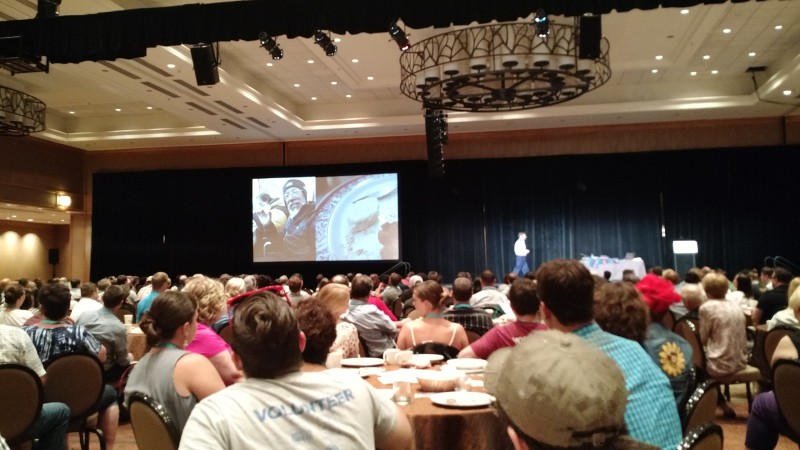
New York Cheese on Mt. Everest Expedition 2017
Fun fact: cheese is one of high altitude mountaineer’s best friends because it gets harder to eat and digest calories at low oxygen levels and cheese is a very concentrated source of protein and fat, and carbs alone don’t help maintain muscle mass. And that only yak and yak-cow hybrids can be productive over 11,000 feet in altitude, so most of the local cheese available in that are is made from made from nak milk (Davidson told us that “yak” refers to the male animal only, and that the Nepalese will giggle if you ask them for some “yak cheese” — I suppose that would be like asking us for some “bull cheese”…
After the opening session we split into the smaller concurrent sessions. Mine was titled “What’s Next: Cheese R&D Comes Out From Behind The Curtain” which consisted of thirteen tables featuring one cheesemaker at each table with one or a few of the cheeses they are currently working on. After everyone was seated the moderator announced that we would have 15 minutes or so at each table learning about the cheeses of that particular cheese maker, and then en masse we would all get up and move to the next table in the series and repeat the exercise until the end of the session.
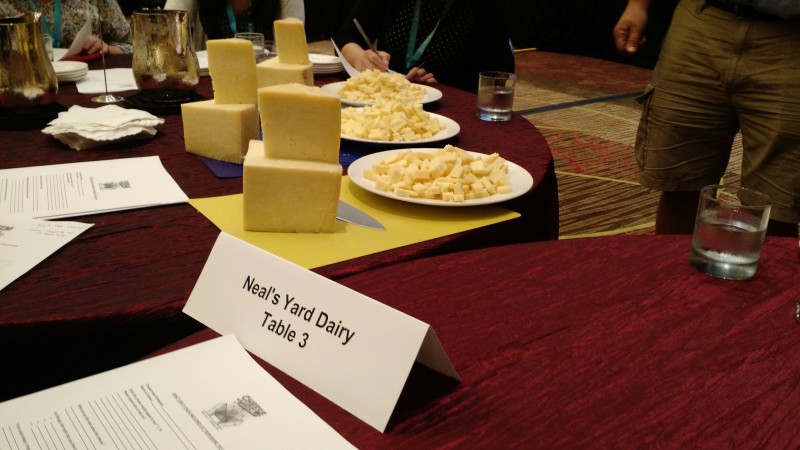
Not every cheese maker featured a new cheese; some had cheeses that they were already making that they felt could be tweaked to either improve that cheese in particular, or else allow them to fork a tweaked version into a new product for them.For example, at my first table — Neals Yard Dairy — they were tweaking the aging of Kirkham’s Lancashire cheese. It is typically a mild example of the British cheese style (with Cheddar it’s most famous representative) with a light crumbly texture and a nice subtle grassy sour milk flavor. Typically they age this cheese at “cellar” temperature, but they began to realize that when they left the cheese out at “room temperature” overnight the flavor deepened text began to be more creamy. And historically theses cheeses were aged up in the farmers attic rather than in a cellar below ground, so they wondered what would happen if they aged the cheese at a bit of a warmer temperature, say 16degC (about 60degF). The result is a much richer cheese with amore aggressive nutty flavor and more pasty texture.
We tried three examples: A) one typical cheese kept refrigerated until just before the tasting; B) one typical cheese that had been left at room temp overnight; and C) one of their experimental wheels aged at a higher temp through out the aging. Despite coming from the same wheel, A was different than B, with B noticably softer textured and a little “stronger” flavored. Then C was totally different, even though it was from the same cheese batch as the wheel that was made into A and B. Very much nuttier and richer and creamier on the palatte. Still the “normal” Kirkham’s is the cheese they’ve been selling for several decades and is one of their most popular cheeses, so they didn’t feel right transitioning new aging method for all of their Kirkham’s wheels, so they have begun selling them both while explaining the difference. Neals Yard expected that many consumers would start buying the new version, which would shrink the sales of the old version, but surprisingly they now sell more of the old version, as well as a good amount of the new version.
Next we switched to a table with Old Chatham Sheepherds cheeses where they had three different cheese for us to try and wanted our feedback on: a goats milk blue, a Jersey cows milk alpine style, and a pure sheep milk feta. Eric, the representative from Old Chatham said that the blue was “just past peak” at five months, but it did not come across as too peppery or bitter the way older blues sometimes can. It was very nice with a definite but not too strong goat note. The alpine style was aged 18 months and you could tell by the little tyrosine crystals that had formed in the firm yellow paste that featured tiny gas bubbles. The feta was incredibly mild, mostly with a soft brine and acid flavor. Interestingly it didn’t even have a creamy texture that I would have expected of a full sheep milk feta. Eric sais that they were still working on the feta and expected to start experimenting with whey brines in the future.
Jasper Hill held our next table and featured two different cheeses, one from their Creamery and one from their Cellars. We first tried one of their first products from their Cellars, the Cabot Clothbound Cheddar. In this case they were taking an existing product and beginning a program that would sort the CCC into categories based on four different flavor profiles that they typically found in different batches: Umami Caramel, Chicken Broth Pineapple, Yolky and Bright, and Brown Butter and Toast. The sorting initially during initial tasting helps them with their different customers who each preferred a different profile for their customers, and now can order batches based on the profile. Then, depending on the aging characteristics they find in each batch they will hold back certain batches that appear to be fit for longer aging, and now they have developed a new line of the CCC called Black Label Select to market these “ideal” versions of each tasting profile. We tasted only one of the BLS profiles, their Umamai Caramel, and it was like a light brown miso drizzled with burnt sugar. It was balanced but powerful. I can’t wait to taste the other profiles.
The other Jasper Hill cheese was something they have been working on for years. I was first introduced to it at the 2015 ACS conference in Providence where, almost as an afterthought in a session dedicated to defining “When Is Cheese Ripe” (answer: whenever you like to eat it) the speaker from Jasper Hill let us taste a really new cheese they were working on that was an acid set version of a bloomy rind, otherwise exactly the same as their Moses Sleeper cheese which is rennet set and “stabilized” with thermo cultures. He wanted feedback on the difference between it and their Moses Sleeper.
And recently Jasper Hill creamery has been talking about their efforts to identify the indigenous cheese cultures they find in their raw milk in an attempt to create their own cultures from their own microflora. Now I had a chance to try their lactic set bloomy disc again, two years into this experiment. First they pointed out two tell-tale visual clues that you have a local culture lactic set bloomy disc: there is a SHARP rind corner around the top and bottom of the disk, and you can also see that the outer edge of the disk looks slightly “crumpled” which is what happens as the acid keeps developing in the mold and the curds begin to really shrink in on themselves. She also warned us that the cheese we would be tasting was a bit young (4 weeks) and was more bitter than they liked. You could see there was still a solid center in the cheese (another sign of a lactic set since “stabilized” bloomies tend to ripen very evenly through the paste) but it wasn’t chalky, and the surrounding paste was soft. There was a bitter component that I tasted, but it was very pleasant, not harsh at all, and there was SO MUCH other flavor and complexity going on around that bitterness that you couldn’t focus on the bitterness. She told us that when they have a good batch there is a “clams in cream sauce” heavy umami flavor that comes out, and I could begin to sense that as the cheese lingered and warmed up on my tongue. Really good! I look forward to tasting “one of the good batches.”
Sweetgrass Dairy is in southern Georgia near the Florida line where the same family has raised and milked Jersey cows for generations. The newest generation has moved on into cheese making as a way to diversify and they now have six regular cheeses that they make and they are developing two more, which we tasted.

The first was a beautiful natural rind cheese that started out as a tomme style but they really wanted to pair this cheese with a local beer and started washing the rind with beer hoping that it would translate to the flavor of the cheese. While they got a beautiful washed rind for their efforts, the beer flavors remained absent inside. So they got creative and decided to edge the cheese make more toward a gouda or havarti and wash the curds, but with 110degF beer instead of water. Now you’re talking. They also were shooting for a higher moisture cheese that would age quickly because where they live the water table is right up at the surface so basements, let alone cheese caves, aren’t possible to bury, and because of the climate mechanical cooling can get quite expensive over time. Therefore they’ve developed something they call Griffin which was creamy smooth, balanced, and had a nice rich flavor with just a hint of the malty porter they use to wash the curds. Interestingly it had The Most Beautiful Rind and others besides me noticed that as well.
Their other trial cheese they’re calling Anders and it’s a two month old washed rind cheese that looks like a funky camembert, but tastes a lot like a funky buttery Harbison, and the paste of the ones we tried were definitely “spoonable” like the Harbison. They call it a “butter bomb” and I concur, really featuring that rich Jersey milk, but there was balance and complexity as well. I think they have two winners.

At my final table at the tasting we met Flora, a new ashed aged goat cheese from Capriole in Indiana. The most distinctive “feature” of this new cheese for them is the size, which is just under a pound in a camembert like disk. They also switched up their normal culture mix to create a more lemony acid-forward flavor. The examples we were trying were a big younger than what they would typically ship — two weeks — but ideally they’d like the cheese to arrive at a cheese shop at four weeks at which point it would then have about a forty day shelf life near peak flavor and texture. The cheese we tasted was still on the chalk side but it definitely featured that light citrus element mixing nicely with the salt and the goaty flavor. It was really really good. And a good cheese to end our R & D adventure on.
LUNCH
I was typing away during most of the lunch break, wanting to post something, so I missed most of the ACS Business Meeting, but others in the Maine contingent were there for that and could report on any significant news that came up.
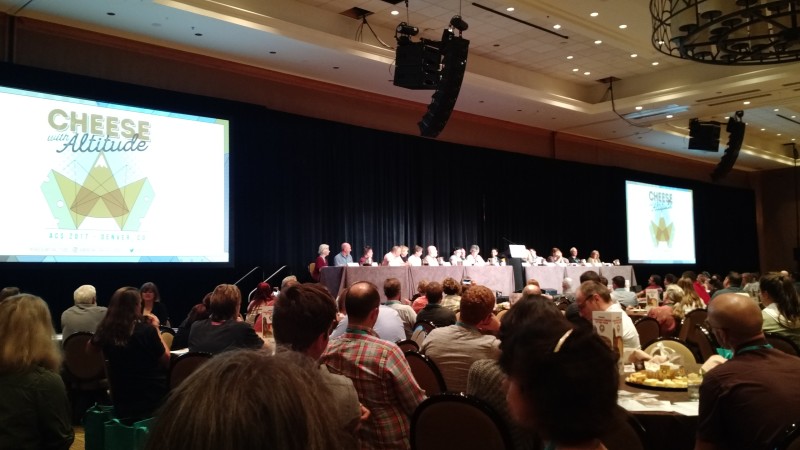
However I joined the Maine contingent in time to see the ceremony awarding a Lifetime Achievement award to Sue Conley and Peggy Smith who founded and still run Cow Girl Creamery based in San Francisco. It’s hard to believe that anyone who likes good cheese hasn’t heard of CGC let alone tried some of their outstanding (and outstandingly consistent) cheeses. I briefly lived in San Francisco, but Alison and I have had close family members living there since the 1980s so we have been out there often, and we have eaten our fair share of CGC cheese over the many years we’ve visted. During the presentation I learned that not only did they found a seminal and ground-breaking American cheese company, but earlier than that they were both involved in the Food Revolution that took hold in the Bay Area in the 1960s and 1970s, working at institutions like Chez Panisse and Betty’s Oceanside Diner as well as partnering with Strauss Family Dairy, one of the spiritual leaders of the organic movement. It was great to see them, and to see them being recognized.
HOPS VS. MALT: A SMACKDOWN WITH CHEESE
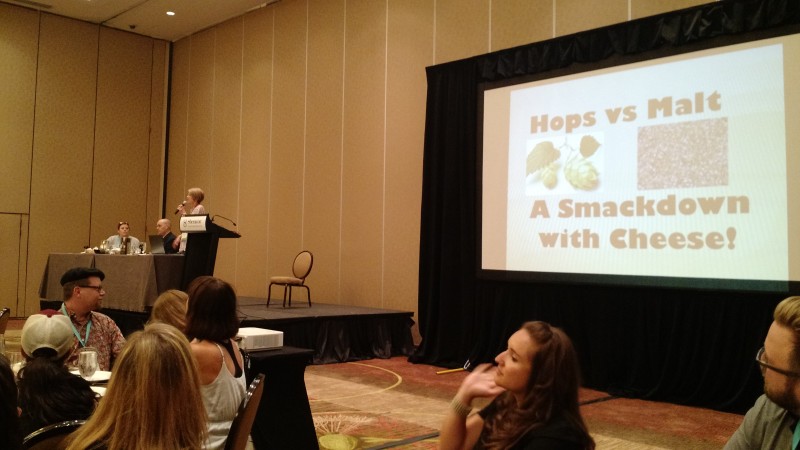
My next session was also a tasting (which is why I didn’t need to rush to lunch!), this time cheese and beer. The title is more marketing that it is meaningful except for this tasting it was to be focused specifically on the two elements of beer — malt and hops — and comparing how those elements pair well (or not so well) with different cheeses. It also featured one of my favorite cheese writers, Janet Fletcher (whose cheese blog “Planet Cheese” is fantastic and is a must read for anyone interested in cheese), as well as a beer expert from the US Brewers Association.
We were limited to two beers — one malt forward brown ale, and one hop forward IPA — and then we tasted five cheeses with both beers and voted on which one we thought paired better. They purposefully chose “middle of the road” versions of each style, so the malt forward beer was not syrupy sweet, and the IPA was not puckerworthy.
And, in the first time I’ve experienced this they used a TXT based voting app to capture everyone’s opinion immediately and then display the votes up on the big screen for everyone to see. It was startlingly easy to use (all you needed was any mobile phone to TXT your vote to a specific number) and best of all it worked flawlessly.
The votes showed something I’ve always thought about beer-cheese pairings: hops are really hard to pair with. I find that malt forward beers, like a Bass Ale or a Belgian style beer, are much easier to pair with cheeses than hops forward beers like IPAs, especially American IPAs that end to be Smackdown Hops Bombs…anyway, below is a list of the cheeses that we sampled and how the pairings were voted.
Bonne Bouche: most of you probably know that this is an ash aged lactic goat cheese of medium form. And the version that we were given was perfectly a pointe — buttery, smooth, slighlty goaty and salty and very umami. I voted for the IPA with this one because it kind of cut through the richness, but I thought it was good with both beers, actually. The crowd at the tasting mostly agreed but leaned toward the malty beer:
56% Brown Beer
Farmstead Toma: this is a very light and supple cheese from Point Reyes Cheese with a milky flavor, very mild. I also voted for the IPA because I knew it wouldn’t get much love in the tasting, but again I thought it could go well with both beers. An interesting aspect is how the fat in this cheese kind of coated your tongue allowing you to taste more and different flavors in both beers, but this was pronounced because it kind of nullified the hops assault in the IPA. Again the crowd went mezza mezza:
56% Brown Beer
Queso de Mano: this is a hard goat cheese from Colorado’s own Haystack Mountain Creamery. Typically it’s sold at 4 months when its still supple, but this was a “special wheel” that the cheese maker set aside just for this tasting, and it was a year old and quite brittle. But with that age came the caramel complexity that you get in good aged cheeses, and that pushed the vote farther into the Brown Ale’s corner:
60% Brown Beer
Grand Cru Surchoix: On to a true aged alpine style cheese (from Emmi Roth) that was terribly emblematic of its style: nutty, brothy, balanced. Again, those caramel tones paired perfectly with the Brown Ale and we’re looking at a runaway lead in the “Smackdown”:
64% Brown Beer
Tumbleweed Cheddar: by this point our presenters were dispairing about the IPA “losses” even though it showed a good portion of these food professionals (who had, one would imagine, veteran palates) were picking the IPA, just not overwhelmingly. So there was some heavy lobbying going one while this cheese (from 5 Spoke) was passed around each table. Our table’s chunk of cheese actually had quite a bit of incidental blue veining, which I thought would make it difficult for an IPA vote, but the cheese itself was quite “bright” and light for a cheddar, and the acidity in the cheese was picked up by the acidity in the IPA as the hops were toned down by the fatty cheese on the tongue:
66% IPA
Bayley Hazen Blue: This extreme cheese at the end of our tasting was never going to bend the IPAs way no matter what, but then this sample of Jasper Hill’s flagship blue cheese was also perfectly a pointe, a cream brothy bluey deep dark balanced bacony bomb on the palate. I voted for the Brown Ale but still the IPA performed respectively:
65% Brown Beer
Fletcher reminded us that they had “pared this pairing down” to just malt v. hops, but there is another style of beer which is YEAST forward beers such as Belgian Wit, or the summer Saisson or Farmhouse style beers. She recommended serving soft ripened cheeses like bloomies, or Geos.
Fletcher was asked about the newly popular sour beers and how to pair with those styles. She recommended a good stinky washed rind cheese with those, thought she didn’t think any good cheese would pair well with some of the beers that can end up tasting like raspberry vinegar…maybe at the next ACS there will be another Smackdown to settle that question?
Sorry. I couldn’t resist these last few shots of the night closing in on downtown Denver:








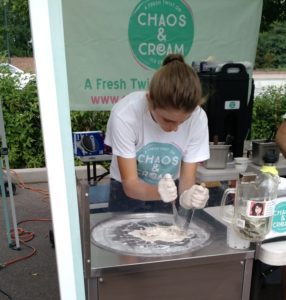 The Cherry Creek Farmers Market sets up twice a week from 9am to 1pm — Wednesdays and Saturdays. It was about the same size as the Belfast Farmers Market where I set up, but it had a different variety of items available beyond four veg and fruit producers. Most unusual was a vendor called Chaos and Cream that “cooked up” ice cream with your choice of mix-ins to order using an unusual device. In the place of what might be a “griddle” they used a large round plate that was super chilled. They ladeled ice cream base onto the plate as if it were pancake or crepe batter, sprinkled on the chosen “mix-ins” and then went to work scraping and chopping the congealing ice cream mixture, presumably incorporating enough air to make it “ice cream” as opposed to custard cubes. That was fun to see.
The Cherry Creek Farmers Market sets up twice a week from 9am to 1pm — Wednesdays and Saturdays. It was about the same size as the Belfast Farmers Market where I set up, but it had a different variety of items available beyond four veg and fruit producers. Most unusual was a vendor called Chaos and Cream that “cooked up” ice cream with your choice of mix-ins to order using an unusual device. In the place of what might be a “griddle” they used a large round plate that was super chilled. They ladeled ice cream base onto the plate as if it were pancake or crepe batter, sprinkled on the chosen “mix-ins” and then went to work scraping and chopping the congealing ice cream mixture, presumably incorporating enough air to make it “ice cream” as opposed to custard cubes. That was fun to see.  I decided to have lunch there as well, finding one single perfectly ripe peach from one of the fruit farmers, and then complementing that with two “Brunch Tacos” with different fillings. They both contained scrambled eggs in their filling, which seems to be what added the “brunch” qualifier.
I decided to have lunch there as well, finding one single perfectly ripe peach from one of the fruit farmers, and then complementing that with two “Brunch Tacos” with different fillings. They both contained scrambled eggs in their filling, which seems to be what added the “brunch” qualifier.